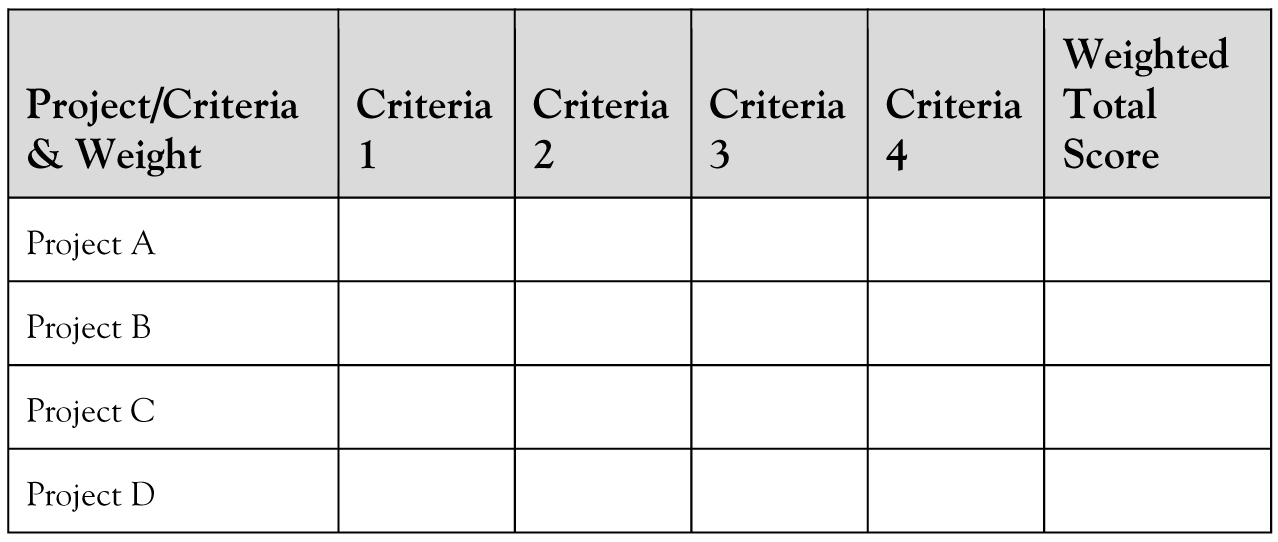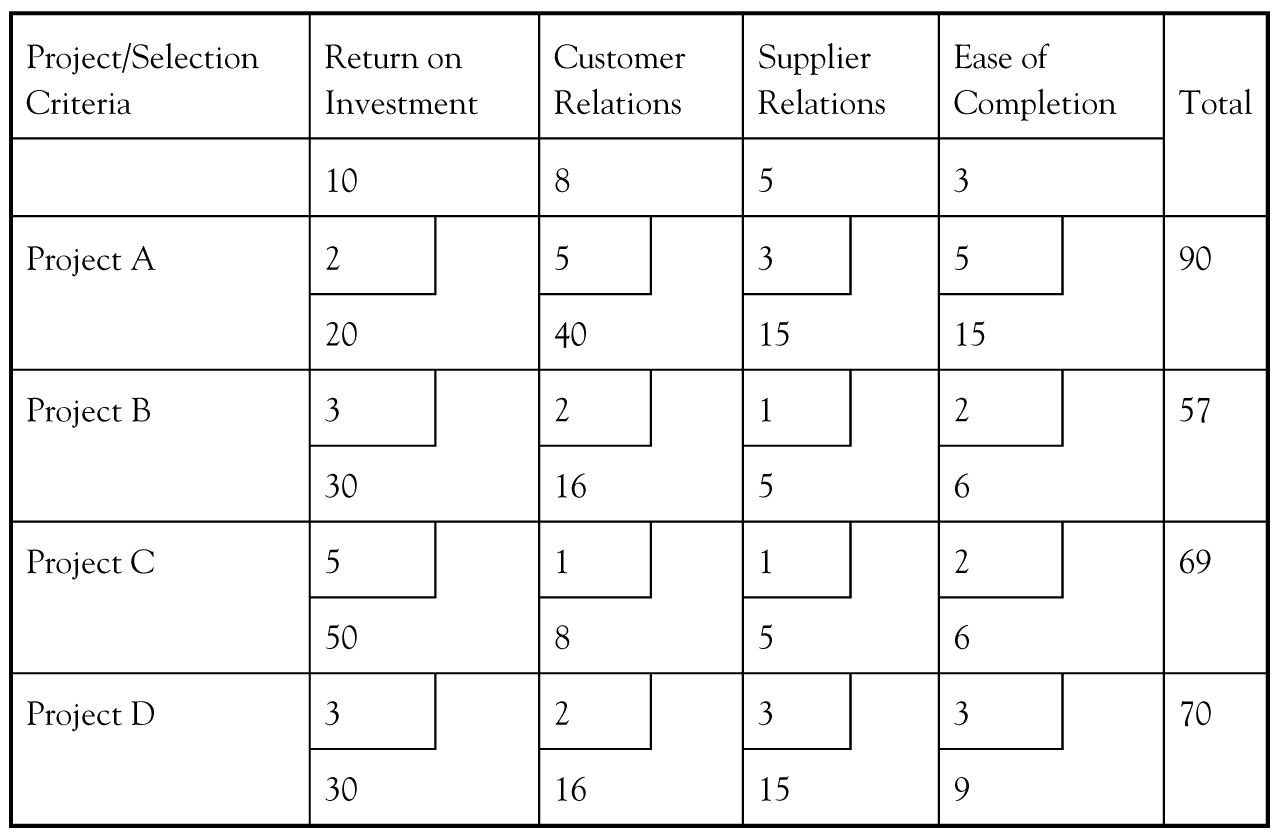Selecting, Prioritizing, and Resourcing Projects
Good practice for leadership team in an organization is after they complete strategic planning, determine the best portfolio of projects and other work that will enable them to achieve their strategy subject to the limits on people and other resources and the amount of risk they are willing to accept. One straightforward way to ensure they select, prioritize, and resource a good portfolio of projects is to use the matrices described here. The first is a project selection matrix. A blank project selection matrix is shown in Exhibit A2.1.
Exhibit A2.1.
Project Selection Matrix

To choose projects with a selection matrix, an accord must be reached as to the most important criteria for undertaking a project. For example, is it projected ROI? Feasibility?Competitive advantage? You should choose a few important criteria, then determine these criteria’s importance relative to one another by assigning each a number between 1 and 10 (1 being least important, 10 being most important). It is imperative you determine the criteria prior to introducing potential projects, since otherwise it is human nature to skew the criteria in favor of pet projects—intentionally or not. Once you have a few weighted criteria, you can start ranking potential projects. On a scale of 1 to 5, how well does each project meet each respective criterion?Suppose everyone agreed up front that Return on Investment was the most important criteria, so you gave it an importance weight of 10. A second criterion, Customer Relations, is almost as important, so you give it an importance weight of 8. Supplier relations is of medium importance, so you give it an importance weight of 5. Ease, on the other hand, is not as important, so you give it an importance weight of 3. It is critical to establish and agree upon these importance weights, shown in Exhibit A2.2, before considering individual projects.
Exhibit A2.2
Project Selection Matrix with Importance Weights

Now each project can be rated on each criterion. Perhaps Project A has only a small potential ROI, so you give it a rating of 2 out of 5. It is not labor-intensive, so you give it the maximum rating, a 5, for Ease.
Your last step will be to multiply each rating by the importance criteria, then total the “points” for each potential project. So, for Project A, you will multiply 10 × 2, which is 20. Add 20 to the 3 × 5 (15) and any other weighted criteria. The higher the score for each potential project, the more it aligns with your organization’s priorities. That said, since these numbers were assigned subjectively, not everyone may be in perfect agreement. It may make sense to adopt any runaway “winners” such as Project A in this case and put to the side any clear-cut “losers” such as Project B, but to have further discussion about any potential projects with similar, middle-of-the-road scores such as Projects C and D. The completed project selection matrix for this example is shown in Exhibit A2.3.
Exhibit A2.3
Completed Project Selection Matrix

Prioritizing Projects
The initial prioritization comes from the project selection matrix just described with the projects receiving the most points having the highest priority. However, many times one project is more urgent than others, two projects are related, or other considerations may impact the relative priority. It is wise for the executives who select the projects to explicitly prioritize them, so everyone knows when there are conflicts, which project gets the priority.
Once the prioritization is complete, it is time to assign key resources to projects starting with the highest priority project. These resources can be anything that is in short supply such as key individuals, money, space, or equipment. Once a particular resource is fully assigned, it is fruitless to start additional projects as the conflicts will delay at least one of them. Many times leaders at this point negotiate to move a particular project up in priority. An example of resources needed for the prioritized projects is shown in Exhibit A2.4. Note the projects are listed in the order they were prioritized in Exhibit A2.3.
Exhibit A2.4
Project Resources Needed

Once we know how much is required for each type of critical resource on each of our prioritized projects, we also need to know how much availability each key resource has (measured in work hours for many resources and dollars for money). We now create one more matrix with availability of each key resource at the top of each column and the projects listed in the order of priority in each row. We assign resources to projects until one type of resource is fully utilized and then we can start no more projects until some of the early ones are completed. In Exhibit A2.5 we start by assigning a sponsor, project manager, and money to the first project and deduct the time or money that project will require to show how much that particular resource has left. For example, the first sponsor only has 70 hours left available, which would not be enough to also sponsor either of the next two prioritized projects. Then we continue to resource the next prioritized project (in this case D) with the required resources of sponsor, project manager and money. Once any of the resources is not enough for another project, we cannot start any more projects until one of the existing ones is complete.
Exhibit A2.5
Project Resourcing Matrix

